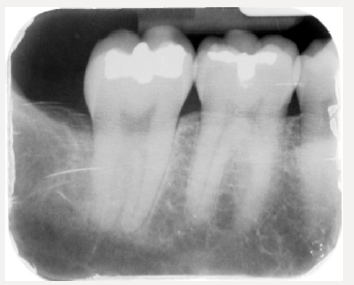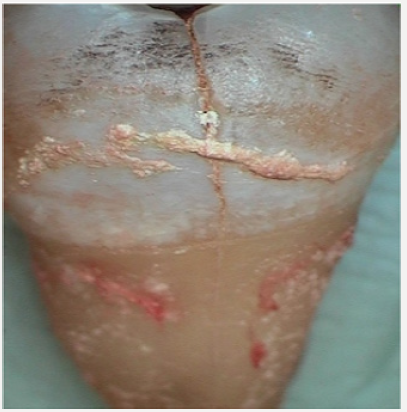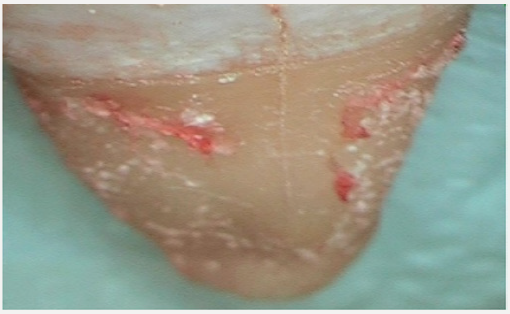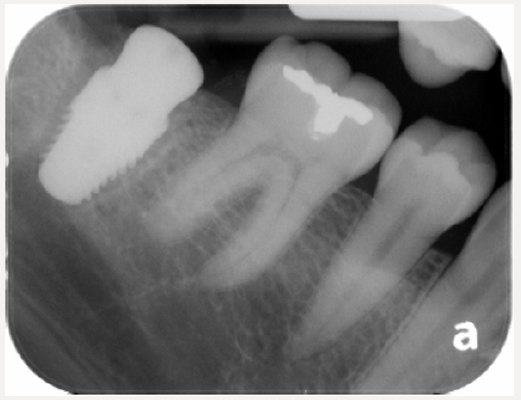Abstract
A patient presented with severe pain in the area of teeth #2 and #31. Prior to seeking dental care, the pain had been so severe together with other clinical manifestations that the patient sought medical attention for a heart attack. After elimination of the occurrence of a m.i., the pain was thought to be dental in origin and dental care was sought. No carious lesions or endodontic problems were found upon radiographic examination. However, careful oral examination revealed the presence of a crack transcending tooth #31. Following tooth extraction and immediate implant placement, no further pain was experienced by the patient.
Introduction
Splits or fractures are the third most common cause of tooth loss in industrialized countries, primarily affecting maxillary molars and premolars, and mandibular molars [1]. However, most clinicians would agree that tooth cracks are difficult to diagnose [2- 4]. Although pain on biting is often considered the most reliable diagnosis for a tooth with a visible crack [5], the most common symptom of a cracked tooth is pain to cold [3]. Further, pain and other symptoms associated with tooth cracks can manifest in different ways, often in areas remote from the actual crack [1]. Interestingly, it has been reported that pain associated with tooth cracks are less likely in teeth with stained cracks or exposed roots, or in non-Hispanic whites [4]. This paper discusses the atypical pain caused by a root fracture in a molar tooth and which manifested in unexpected and misleading ways.
Patient Consultation
A 50 y.o. male patient in good general health presented with pain in the area of teeth #2 and #31. The patient was a dentist and reported that he had experienced severe pain on the left side of his face, with pain extending down his left arm together with heart palpitations and elevated blood pressure. Suspecting a M.I., the patient sought medical care but a visit to the Emergency Room together with blood tests indicated that the patient was not experiencing a heart attack. The pain was ascribed to dental issues on the right side of the face. However, the patient reported no pain on biting or sensitivity to cold.
Clinical Examination
Radiographic examination of the patient, (Figure 1) indicated no carious lesions, sepsis or other issues with his dentition. However, careful intra-oral examination of the teeth indicated the presence of a crack on the distal surface of Tooth #31, (Figure 2). The crack appeared to have initiated from an apparently defective amalgam restoration, (Figure 3), and descended vertically to the apex of the tooth, (Figure 4). This conclusion appears to be justified because the literature indicates that a major predisposing factor to tooth fracture are mesio-occluso-distal restorations with mandibular first molar teeth being particularly affected [6]. Interestingly, the presence of calculus was noted in the buccal enamel and there are indications that this deposit caused widening of the enamel crack. No defects or lesions were noted in any other maxillary or mandibular teeth.
Treatment Regimen
In consultation with the patient, it was decided that the affected tooth could not be salvaged, and it was extracted under local anesthesia. Because the extraction site was infection-free, the periodontal condition was satisfactory, and the bone was solid and well-vascularized, an immediate implant was placed, (Figure 5).
Prognosis
After extraction of tooth #31 and resolution of local anesthesia, the pain was immediately eliminated. Satisfactory healing and osseo-integration are projected for the affected area.
Conclusion
Cracks in teeth weaken them and pain from cracked teeth can be felt in areas remoted from the affected tooth. What was unusual in the present case is the pain was experienced on the other side of the mouth from the affected tooth and intensified to the point that the patient suspected a myocardial infarction. Although tooth crack-induced pain often can be experienced in areas remote from the affected tooth, the existence of pain, so severe that it mimicked a heart attack, and occurring on the other side of the mouth was unusual. This particular case reinforces the need for clinicians to carefully examine all facets of the dentition of patients presenting with oral pain. Cracks in enamel do occur and, as in the present case, may originate from a defective restoration. However, crack progression to the tooth apex and sudden, sharp onset of pain is unusual. Even more unexpected is that the pain was experienced on the opposite jaw to the affected tooth.






No comments:
Post a Comment
Note: only a member of this blog may post a comment.